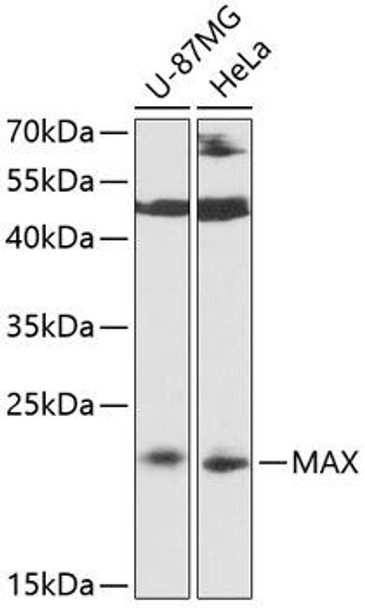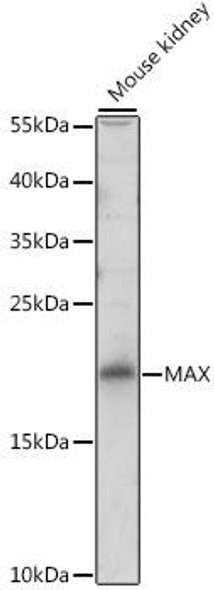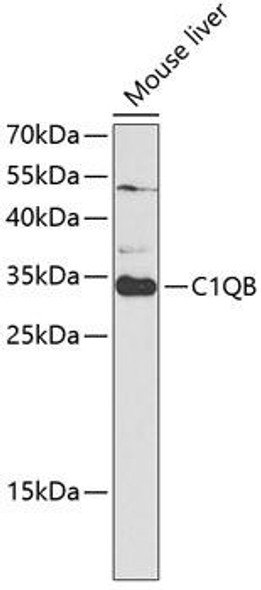Anti-MAX Antibody (CAB0580)
- SKU:
- CAB0580
- Product type:
- Antibody
- Reactivity:
- Human
- Host Species:
- Rabbit
- Isotype:
- IgG
- Antibody Type:
- Polyclonal Antibody
- Research Area:
- Epigenetics and Nuclear Signaling
Frequently bought together:
Description
| Antibody Name: | Anti-MAX Antibody |
| Antibody SKU: | CAB0580 |
| Antibody Size: | 20uL, 50uL, 100uL |
| Application: | WB |
| Reactivity: | Human |
| Host Species: | Rabbit |
| Immunogen: | Recombinant fusion protein containing a sequence corresponding to amino acids 1-1-160 of human MAX (NP_002373.3). |
| Application: | WB |
| Recommended Dilution: | WB 1:500 - 1:1000 |
| Reactivity: | Human |
| Positive Samples: | U-87MG, HeLa |
| Immunogen: | Recombinant fusion protein containing a sequence corresponding to amino acids 1-1-160 of human MAX (NP_002373.3). |
| Purification Method: | Affinity purification |
| Storage Buffer: | Store at -20°C. Avoid freeze / thaw cycles. Buffer: PBS with 0.02% sodium azide, 50% glycerol, pH7.3. |
| Isotype: | IgG |
| Sequence: | MSDN DDIE VESD EEQP RFQS AADK RAHH NALE RKRR DHIK DSFH SLRD SVPS LQGE KASR AQIL DKAT EYIQ YMRR KNHT HQQD IDDL KRQN ALLE QQVR ALEK ARSS AQLQ TNYP SSDN SLYT NAKG STIS AFDG GSDS SSES EPEE PQSR KKLR MEAS |
| Gene ID: | 4149 |
| Uniprot: | P61244 |
| Cellular Location: | Cell projection, Nucleus, dendrite |
| Calculated MW: | 9kDa/11kDa/12kDa/15kDa/17kDa/18kDa |
| Observed MW: | 22kDa |
| Synonyms: | MAX, bHLHd4 |
| Background: | The protein encoded by this gene is a member of the basic helix-loop-helix leucine zipper (bHLHZ) family of transcription factors. It is able to form homodimers and heterodimers with other family members, which include Mad, Mxi1 and Myc. Myc is an oncoprotein implicated in cell proliferation, differentiation and apoptosis. The homodimers and heterodimers compete for a common DNA target site (the E box) and rearrangement among these dimer forms provides a complex system of transcriptional regulation. Mutations of this gene have been reported to be associated with hereditary pheochromocytoma. A pseudogene of this gene is located on the long arm of chromosome 7. Alternative splicing results in multiple transcript variants. |
| UniProt Protein Function: | MAX: a transcription factor. Forms a DNA- binding protein complex with MYC or MAD. The MYC-MAX complex is a transcriptional activator, whereas the MAD-MAX complex is a repressor. CPG methylation of the recognition site greatly inhibits DNA binding, suggesting that DNA methylation may regulate the MYC/MAX complex in vivo. May repress transcription via the recruitment of a chromatin remodeling complex containing H3-K9 histone methyltransferase activity. Three alternatively spliced isoforms have been reported. |
| UniProt Protein Details: | Protein type:DNA-binding; Transcription factor Chromosomal Location of Human Ortholog: 14q23 Cellular Component: nucleoplasm; PML body; dendrite; cytoplasm; nucleus Molecular Function:protein binding; protein homodimerization activity; sequence-specific DNA binding; protein heterodimerization activity; transcription coactivator activity; transcription cofactor activity; protein complex binding; transcription factor activity Biological Process: transcription from RNA polymerase II promoter; neuron apoptosis; regulation of transcription, DNA-dependent; retina development in camera-type eye; protein complex assembly; response to axon injury; cellular response to starvation; response to insulin stimulus |
| NCBI Summary: | The protein encoded by this gene is a member of the basic helix-loop-helix leucine zipper (bHLHZ) family of transcription factors. It is able to form homodimers and heterodimers with other family members, which include Mad, Mxi1 and Myc. Myc is an oncoprotein implicated in cell proliferation, differentiation and apoptosis. The homodimers and heterodimers compete for a common DNA target site (the E box) and rearrangement among these dimer forms provides a complex system of transcriptional regulation. Mutations of this gene have been reported to be associated with hereditary pheochromocytoma. A pseudogene of this gene is located on the long arm of chromosome 7. Alternative splicing results in multiple transcript variants. [provided by RefSeq, Aug 2012] |
| UniProt Code: | P61244 |
| NCBI GenInfo Identifier: | 47117704 |
| NCBI Gene ID: | 4149 |
| NCBI Accession: | P61244.1 |
| UniProt Secondary Accession: | P61244,P25912, P52163, Q14803, Q96CY8, A6NH73, A8K265 A8K4G4, A8K824, |
| UniProt Related Accession: | P61244 |
| Molecular Weight: | 160 |
| NCBI Full Name: | Protein max |
| NCBI Synonym Full Names: | MYC associated factor X |
| NCBI Official Symbol: | MAX |
| NCBI Official Synonym Symbols: | bHLHd4 |
| NCBI Protein Information: | protein max; class D basic helix-loop-helix protein 4 |
| UniProt Protein Name: | Protein max |
| UniProt Synonym Protein Names: | Class D basic helix-loop-helix protein 4; bHLHd4; Myc-associated factor X |
| Protein Family: | Protein max |
| UniProt Gene Name: | MAX |
| UniProt Entry Name: | MAX_HUMAN |








